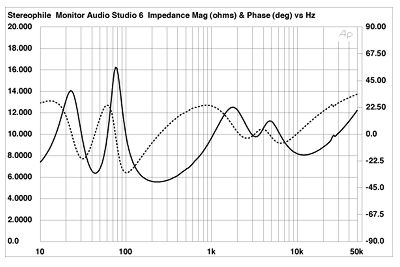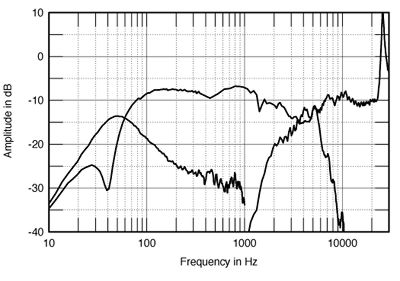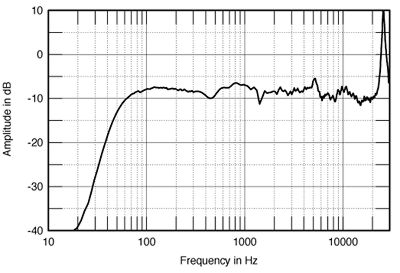| Columns Retired Columns & Blogs |
Monitor Audio Studio 6 loudspeaker Measurements
Sidebar 3: Measurements
The Studio 6's impedance magnitude and phase, measured using the magazine's Audio Precision System One, are shown in fig.1. Dropping below 6 ohms only in the lower midrange—the minimum value is 5.55 ohms at 243Hz—and remaining above 8 ohms for much of the time, this graph implies that the Studio 6 should work well even with current-starved tube amplifiers. The port is tuned to 45Hz, the impedance magnitude featuring a saddle centered on that frequency.

Fig.1 Monitor Audio Studio 6, electrical impedance (solid) and phase (dashed) (2 ohms/vertical div.).
Unlike many of the speakers I have reviewed of late, there are no wrinkles noticeable in the impedance trace (other than one at 26kHz, which coincides with the tweeter's main resonant mode). This implies a more-rigid-than-usual cabinet construction (see later). The speaker's sensitivity (calculated using B-weighted noise) is moderately high for a small two-way design at around 87dB/W/m.
Fig.2 shows the individual responses of the port, woofer, and tweeter, measured with the DRA Labs MLSSA system and a B&K 4006 microphone calibrated to be flat on-axis. The measuring distance was 45" on the tweeter axis, while the port response and the woofer response below 300Hz were both taken in the nearfield. Though the minimum in the woofer output occurs at 40Hz, the corresponding peak in the port output is centered a little higher in frequency, at 50Hz. There are no "organ-pipe" resonances noticeable in the port response, which rolls out smoothly in the lower midrange.

Fig.2 Monitor Audio Studio 6, individual anechoic responses of port, woofer, and tweeter response on tweeter axis at 45" and corrected for microphone response, with nearfield woofer and port responses below 300Hz and 800Hz, respectively.
The woofer has a slight prominence in its on-axis output in the upper midrange; a sharp woofer peak at 5.1kHz, coincident with one in the tweeter's output, is followed by a steep acoustic rollout, despite the first-order nature of the crossover filters. Although the crossover frequency is specified as 3.2kHz, acoustically, both drive-units overlap significantly in the entire 3-6kHz octave. The tweeter appears to have a dual electrical high-pass slope: 6dB/octave down to 2kHz, then an accelerated slope.
The tweeter features a 20dB-high peak at its 26kHz resonance frequency. Though in itself this will be inaudible, its height suggests that, when excited, it might modify the drive-unit's audio-band behavior with intermodulation products. Though CD sources, of course, don't offer any energy worth speaking of at this frequency, LPs played with a good MC cartridge can do so.
The answer to the question of how these individual responses integrate can be seen in fig.3. This splices the quasi-anechoic response averaged across a 30 degrees horizontal window to the magnitude derived from the complex sum of the nearfield woofer and port responses, weighted in the ratio of the square roots of their areas. (There are two ports, remember.) The overall trend is flat, though the top two octaves are shelved down by 2dB or so, which correlates with the rather mellow balance noted in the auditioning. The upper midrange, the 700-1200Hz region, is a little prominent, while the 5.1kHz peak also stands out. In the bass, the -6dB point lies at 47Hz, implying relatively good extension for such a small cabinet. The 24dB/octave reflex rollout, however, means that very low notes, even with a degree of reinforcement from the room, will not be audible, as I found in my auditioning.

Fig.3 Monitor Audio Studio 6, anechoic response on tweeter axis at 45" averaged across 30 degrees horizontal window and corrected for microphone response, with complex sum of nearfield woofer and port responses below 300Hz.
Laterally (fig.4), the speaker's top two octaves progressively roll off with increasing off-axis angle, though a notch centered on 4.2kHz develops due to the woofer's narrow directivity in this region. The 5.1kHz peak is also relatively more prominent off-axis, which might be expected to make the in-room sound a little bright unless well-damped. Vertically (fig.5), the outputs of the two drivers remain integrated as long as the listener is between the ports and the top of the cabinet. Above and below that range, a major crossover suckout develops: once again, never listen to this speaker standing up—it'll sound very hollow!

Fig.4 Monitor Audio Studio 6, horizontal response family at 45", normalized to response on tweeter axis, from back to front: differences 90 degrees-15 degrees off-axis; reference response; differences 15 degrees-90 degrees off-axis.

Fig.5 Monitor Audio Studio 6, vertical response family at 45", normalized to response on tweeter axis, from back to front: difference in response 15 degrees above tweeter axis; difference 7.5 degrees above tweeter axis; difference level with cabinet top; reference response; difference level with ports; difference on woofer axis; difference level with base of cabinet.
Carrying out a spatially averaged 1/3-octave spectrum analysis for left and right speakers individually in-room gives the curve shown in fig.6, which is very flat through the low and mid-treble. The high treble is suppressed somewhat, correlating with the mellow balance noted during auditioning, while again there's a trace of excess energy in the 5kHz region. The excess at 63Hz and 200Hz, and the dips at 50Hz and 250Hz, are room effects that have not been completely eliminated by the spatial averaging; the response trend is slightly forward in the upper midrange but otherwise basically neutral, with an in-room bass response that usefully extends down to the 40Hz band, the lowest notes of the 4-string electric and acoustic basses.

Fig.6 Monitor Audio Studio 6, spatially averaged 1/3-octave response in JA's listening room.
- Log in or register to post comments




































